2007 CHEVROLET AVALANCHE hood open
[x] Cancel search: hood openPage 120 of 618

Testing the Alarm
The alarm can be tested by following these steps:
1. From inside the vehicle, lower the driver’s
window and open the driver’s door.
2. Activate the system by locking the doors with
the power door lock switch while the door is
open, or with the RKE transmitter.
3. Get out of the vehicle, close the door and wait
for the security light to go out.
4. Then reach in through the window, unlock the
door with the manual door lock and open the
door. This should set off the alarm.
While the alarm is set, the power door unlock
switch is not operational.
If the alarm does not sound when it should but the
headlamps �ash, check to see if the horn works.
The horn fuse may be blown. To replace the fuse,
seeInstrument Panel Fuse Block on page 548
andUnderhood Fuse Block on page 551.
If the alarm does not sound or the headlamps
do not �ash, the vehicle should be serviced
by your dealer.
PASS-Key®III+
The PASS-Key®III+ system operates on a radio
frequency subject to Federal Communications
Commission (FCC) Rules and with Industry
Canada.
This device complies with Part 15 of the
FCC Rules. Operation is subject to the
following two conditions:
1. This device may not cause harmful
interference.
2. This device must accept any interference
received, including interference that may
cause undesired operation.
This device complies with RSS-210 of Industry
Canada. Operation is subject to the following
two conditions:
1. This device may not cause interference.
2. This device must accept any interference
received, including interference that may
cause undesired operation of the device.
Changes or modi�cations to this system by
other than an authorized service facility could
void authorization to use this equipment.
120
Page 127 of 618

To Use the Engine Coolant Heater
1. Turn off the engine.
2. Open the hood and unwrap the electrical
cord. The cord is located on the driver’s
side of the engine compartment, near
the power steering �uid reservoir.
3. Plug the cord into a normal, grounded
110-volt AC outlet.
{CAUTION:
Plugging the cord into an ungrounded
outlet could cause an electrical shock.
Also, the wrong kind of extension cord
could overheat and cause a �re. You
could be seriously injured. Plug the cord
into a properly grounded three-prong
110-volt AC outlet. If the cord will not
reach, use a heavy-duty three-prong
extension cord rated for at least 15 amps.
4. Before starting the engine, be sure to unplug
and store the cord as it was before to keep it
away from moving engine parts. If you do
not, it could be damaged.How long should you keep the coolant heater
plugged in? The answer depends on the outside
temperature, the kind of oil you have, and
some other things. Instead of trying to list
everything here, we ask that you contact your
dealer in the area where you will be parking your
vehicle. The dealer can give you the best
advice for that particular area.
Active Fuel Management™
Your vehicle’s V8 engine may have Active Fuel
Management™. This system allows the engine to
operate on either all or half of its cylinders,
depending on the driving conditions.
When less power is required, such as cruising at a
constant vehicle speed, the system will operate
in the half cylinder mode, allowing your vehicle to
achieve better fuel economy. When greater
power demands are required, such as accelerating
from a stop, passing, or merging onto a freeway,
the system will maintain full-cylinder operation.
Your vehicle has an Active Fuel Management™
indicator. For more information on using this
display seeDIC Operation and Displays (With
DIC Buttons) on page 258orDIC Operation and
Displays (Without DIC Buttons) on page 264.
127
Page 238 of 618
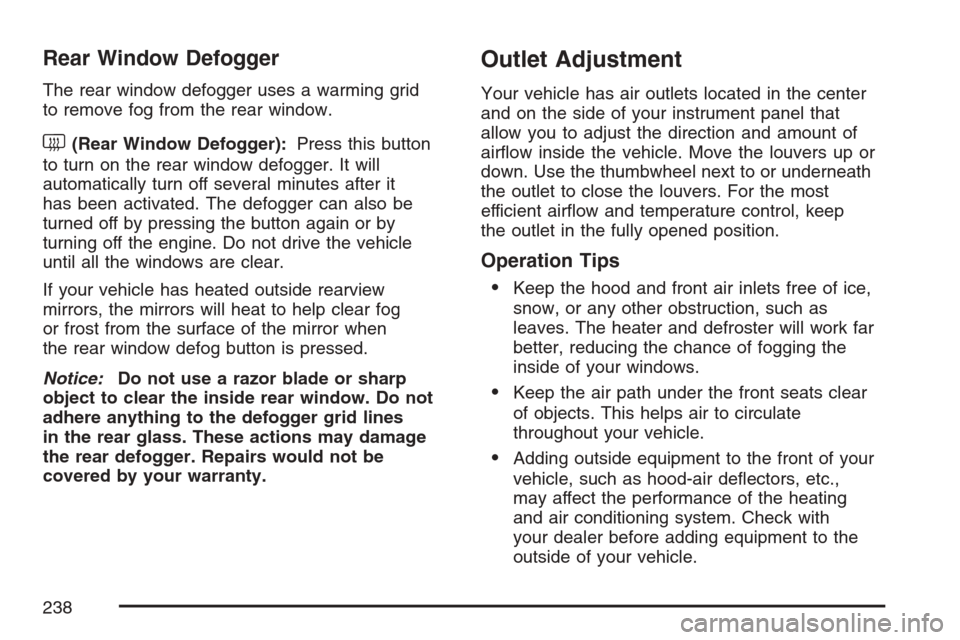
Rear Window Defogger
The rear window defogger uses a warming grid
to remove fog from the rear window.
<(Rear Window Defogger):Press this button
to turn on the rear window defogger. It will
automatically turn off several minutes after it
has been activated. The defogger can also be
turned off by pressing the button again or by
turning off the engine. Do not drive the vehicle
until all the windows are clear.
If your vehicle has heated outside rearview
mirrors, the mirrors will heat to help clear fog
or frost from the surface of the mirror when
the rear window defog button is pressed.
Notice:Do not use a razor blade or sharp
object to clear the inside rear window. Do not
adhere anything to the defogger grid lines
in the rear glass. These actions may damage
the rear defogger. Repairs would not be
covered by your warranty.
Outlet Adjustment
Your vehicle has air outlets located in the center
and on the side of your instrument panel that
allow you to adjust the direction and amount of
air�ow inside the vehicle. Move the louvers up or
down. Use the thumbwheel next to or underneath
the outlet to close the louvers. For the most
efficient air�ow and temperature control, keep
the outlet in the fully opened position.
Operation Tips
Keep the hood and front air inlets free of ice,
snow, or any other obstruction, such as
leaves. The heater and defroster will work far
better, reducing the chance of fogging the
inside of your windows.
Keep the air path under the front seats clear
of objects. This helps air to circulate
throughout your vehicle.
Adding outside equipment to the front of your
vehicle, such as hood-air de�ectors, etc.,
may affect the performance of the heating
and air conditioning system. Check with
your dealer before adding equipment to the
outside of your vehicle.
238
Page 270 of 618

ENGINE OVERHEATED STOP ENGINE
Notice:If you drive your vehicle while the
engine is overheating, severe engine damage
may occur. If an overheat warning appears
on the instrument panel cluster and/or
DIC, stop the vehicle as soon as possible.
SeeEngine Overheating on page 460for
more information.
This message displays and a chime sounds
if the engine cooling system reaches unsafe
temperatures for operation. Stop and turn off the
vehicle as soon as it is safe to do so to avoid
severe damage. This message clears when the
engine has cooled to a safe operating temperature.
ENGINE POWER IS REDUCED
This message displays and a chime sounds
when the cooling system temperature gets too
hot and the engine further enters the engine
coolant protection mode. SeeEngine Overheating
on page 460for further information.
This message also displays when the vehicle’s
engine power is reduced. Reduced engine power
can affect the vehicle’s ability to accelerate.If this message is on, but there is no reduction
in performance, proceed to your destination.
The performance may be reduced the next time
the vehicle is driven. The vehicle may be driven
at a reduced speed while this message is on,
but acceleration and speed may be reduced.
Anytime this message stays on, the vehicle
should be taken to your dealer for service as
soon as possible.
FUEL LEVEL LOW
This message displays and a chime sounds if
the fuel level is low. Refuel as soon as possible.
SeeFuel Gage on page 256andFuel on page 435
for more information.
HOOD OPEN
This message displays and a chime sounds if
the hood is not fully closed. Stop and turn off the
vehicle, check the hood for obstructions, and
close the hood again. Check to see if the message
still appears on the DIC.
270
Page 436 of 618
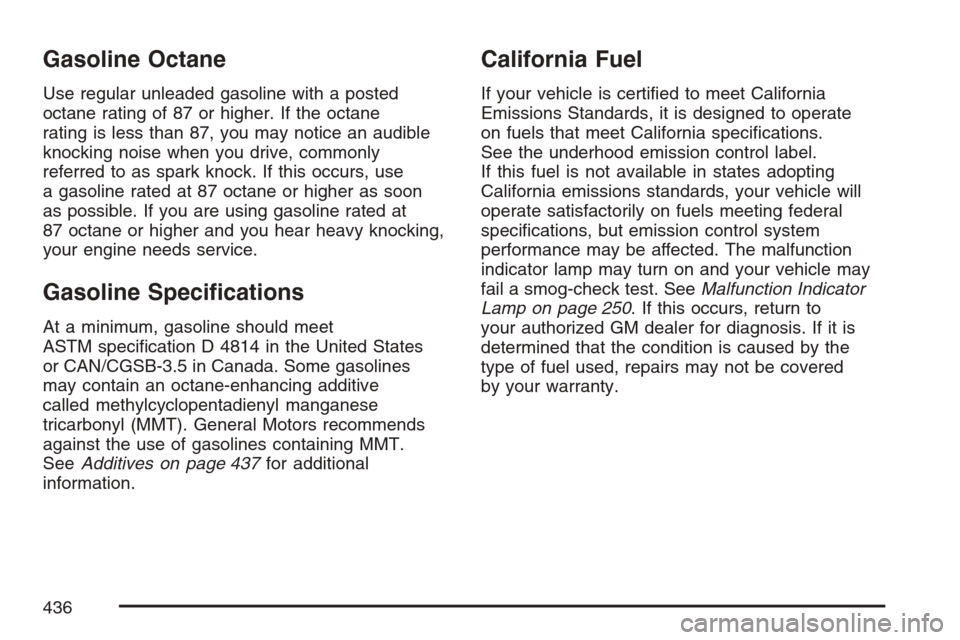
Gasoline Octane
Use regular unleaded gasoline with a posted
octane rating of 87 or higher. If the octane
rating is less than 87, you may notice an audible
knocking noise when you drive, commonly
referred to as spark knock. If this occurs, use
a gasoline rated at 87 octane or higher as soon
as possible. If you are using gasoline rated at
87 octane or higher and you hear heavy knocking,
your engine needs service.
Gasoline Speci�cations
At a minimum, gasoline should meet
ASTM speci�cation D 4814 in the United States
or CAN/CGSB-3.5 in Canada. Some gasolines
may contain an octane-enhancing additive
called methylcyclopentadienyl manganese
tricarbonyl (MMT). General Motors recommends
against the use of gasolines containing MMT.
SeeAdditives on page 437for additional
information.
California Fuel
If your vehicle is certi�ed to meet California
Emissions Standards, it is designed to operate
on fuels that meet California speci�cations.
See the underhood emission control label.
If this fuel is not available in states adopting
California emissions standards, your vehicle will
operate satisfactorily on fuels meeting federal
speci�cations, but emission control system
performance may be affected. The malfunction
indicator lamp may turn on and your vehicle may
fail a smog-check test. SeeMalfunction Indicator
Lamp on page 250. If this occurs, return to
your authorized GM dealer for diagnosis. If it is
determined that the condition is caused by the
type of fuel used, repairs may not be covered
by your warranty.
436
Page 442 of 618
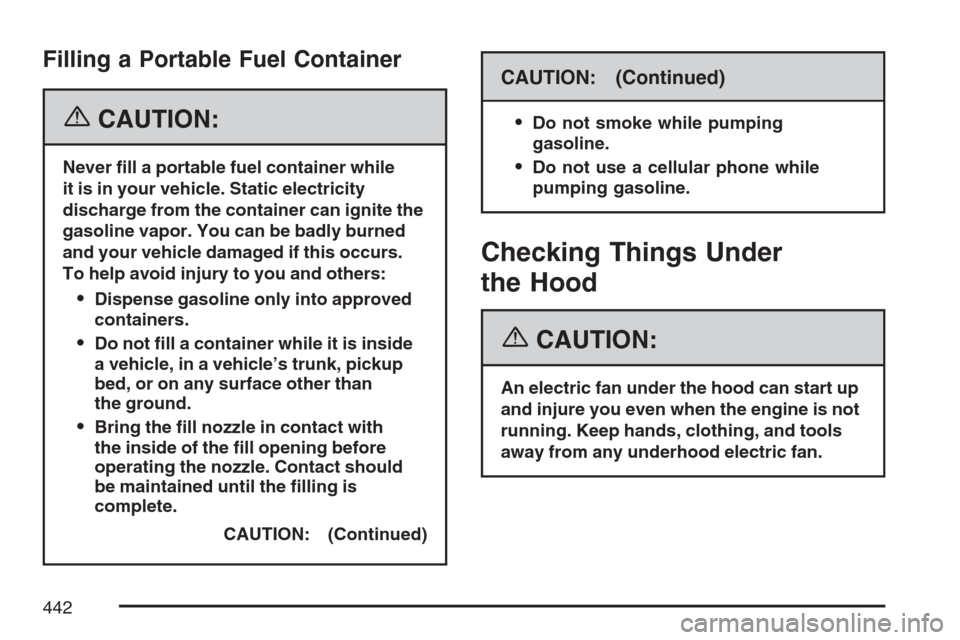
Filling a Portable Fuel Container
{CAUTION:
Never �ll a portable fuel container while
it is in your vehicle. Static electricity
discharge from the container can ignite the
gasoline vapor. You can be badly burned
and your vehicle damaged if this occurs.
To help avoid injury to you and others:
Dispense gasoline only into approved
containers.
Do not �ll a container while it is inside
a vehicle, in a vehicle’s trunk, pickup
bed, or on any surface other than
the ground.
Bring the �ll nozzle in contact with
the inside of the �ll opening before
operating the nozzle. Contact should
be maintained until the �lling is
complete.
CAUTION: (Continued)
CAUTION: (Continued)
Do not smoke while pumping
gasoline.
Do not use a cellular phone while
pumping gasoline.
Checking Things Under
the Hood
{CAUTION:
An electric fan under the hood can start up
and injure you even when the engine is not
running. Keep hands, clothing, and tools
away from any underhood electric fan.
442
Page 443 of 618
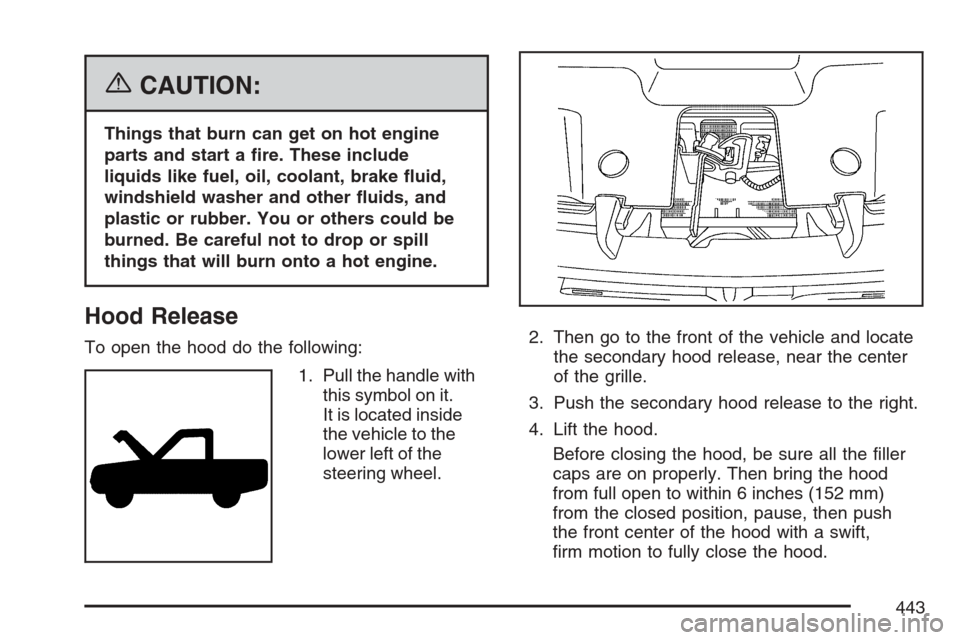
{CAUTION:
Things that burn can get on hot engine
parts and start a �re. These include
liquids like fuel, oil, coolant, brake �uid,
windshield washer and other �uids, and
plastic or rubber. You or others could be
burned. Be careful not to drop or spill
things that will burn onto a hot engine.
Hood Release
To open the hood do the following:
1. Pull the handle with
this symbol on it.
It is located inside
the vehicle to the
lower left of the
steering wheel.2. Then go to the front of the vehicle and locate
the secondary hood release, near the center
of the grille.
3. Push the secondary hood release to the right.
4. Lift the hood.
Before closing the hood, be sure all the �ller
caps are on properly. Then bring the hood
from full open to within 6 inches (152 mm)
from the closed position, pause, then push
the front center of the hood with a swift,
�rm motion to fully close the hood.
443
Page 444 of 618
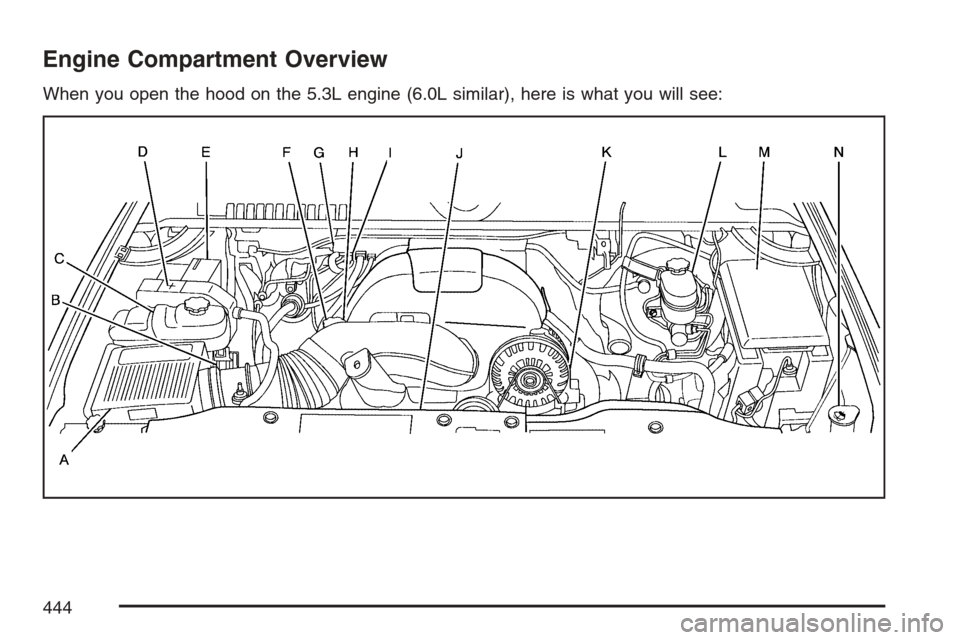
Engine Compartment Overview
When you open the hood on the 5.3L engine (6.0L similar), here is what you will see:
444